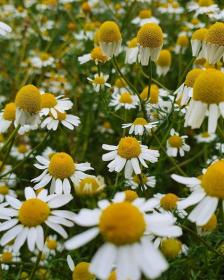Chamomile is one of the most popular and best-documented raw herbal materials. Chamomile flower preparations are used internally to treat digestive disorders such as dyspepsia, epigastric bloating, impaired digestion, and flatulence and externally to treat inflammation and irritation of the skin and mucous membranes, including irritations and infections of the mouth and gums and hemorrhoids.
Chamomile belongs to the Asteraceae family and the genus Matricaria. Chamomile comprises four species: Chamomilla aurea, Chamomilla suaveolens, Chamomilla tzvelevii, and Chamomilla recutita. Synonyms for Chamomilla recutita are i. e. Chamomilla vulgaris, Matricaria chamomilla or Matricaria recutita. Chamomilla recutita is also called German or wild Chamomile.
A different chamomile is the so-called English or Roman chamomile, Anthemis nobilis. However, German Chamomile is mainly used commercially for pharmaceutical and cosmetic applications.
German Chamomile is a medium-sized plant growing from 10 - 80 cm in height. It has erect, branching stems and alternate, tripinnately divided leaves below and bipinnately divided above, with almost filiform lobes. The plant consists of conical flower heads, each bearing white ligulate florets and numerous yellowish orange to pale yellow tubular or disk florets on conical, narrow hollow receptacles with a short peduncle.Commercially used species
Only the flower heads are used for drug preparation. The content of the (-)-α-bisabolol and bisabolol oxide in wild-crafted chamomile species from different geographical regions varies considerably.
The commercially available chamomilla recutita is divided into four chemotypes: Most chamomile essential oils of European origin contain bisabolol oxide A as the main component (Type A).
Essential oils of Argentinian origin contain mainly bisabolol oxide B (Type B). Type C oils (Spanish Type) contain (-)-α-bisabolol as main component whereas in Type D oils (Uniform Type) none of the components predominate. Less critical is a bisabolene oxide A- Type (Anatolian origin), which is matricine-free or has low matricine content.
Cultivation efforts in recent years have led to the diploid chamomile sort Degumille® and the tetraploid chamomile sort Manzana® both with a high concentration of essential oil containing significant amounts of (-)-α-bisabolol and matricine. These are used nowadays for high-grade products. The new Manzana type has some advantages over the Degumille type.Manzana is not susceptible to extraneous pollination with wild chamomile. Furthermore, the Manzana type has improved properties regarding growing and harvesting, has a higher concentration of the valuable (-)-α-bisabolol, and, compared to other tetraploid types, lower concentrations of bisabolol oxides.
